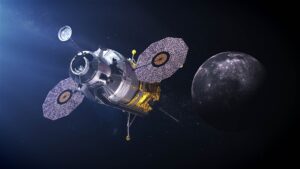” The solicitation, Appendix N of NASA’s Next Space Technologies for Exploration Partnerships (NextSTEP) program, will fund initial studies of landers to support the agency’s later phases of the Artemis program after the initial Artemis 3 landing.
The studies will enable companies to mature their designs for crewed lunar landers and provide feedback to NASA on proposed standards and specifications, such as a series of trade studies on aspects of the lander architecture. The studies would also support specific risk reduction activities proposed by companies for their landers.
NASA announced plans for NextSTEP Appendix N in late April, shortly after awarding a $2.9 billion contract to SpaceX as the sole winner of the Human Landing System (HLS) competition for development of a lander and a single demonstration mission with astronauts. NextSTEP Appendix N is intended to be the first step in the future Lunar Exploration Transportation Services (LETS) program to acquire landing services after the Artemis 3 mission.
“This announcement is a chance for the pioneering private sector to claim their stake in the emerging lunar economy and make history with NASA,” Lisa Watson-Morgan, NASA HLS program manager, said in an agency statement about the new solicitation.
At an industry day May 3, Watson-Morgan said NASA anticipated making “a few” awards at about $15 million each. The request for proposals will support proposals worth up to $45 million, or up to $100 million if options for additional work are exercised. NASA did not disclose how much total funding is available.
Proposals are due to NASA Aug. 2 with awards expected in the fall. That deadline has raised concerns in industry because it comes just two days before the deadline for the Government Accountability Office to rule on protests filed by Blue Origin and Dynetics regarding NASA’s selection of SpaceX for the single HLS award. While the GAO could rule on the protests at any time before Aug. 4, the complexity of the two protests has led both industry observers and NASA officials, including Administrator Bill Nelson, to expect a ruling on Aug. 4.
One industry source, speaking on background, noted that NASA issued the NextSTEP Appendix N request for proposals without first issuing a draft version for comment. It gives the appearance, that person said, of NASA trying to rush this through before the GAO rules on the protests or before Congress weighs in on the program.
A NASA authorization bill included in broader competitiveness legislation passed by the Senate June 8 would direct NASA to select a second HLS company, authorizing about $10 billion for the overall HLS program through 2025. The House has yet to take up its own NASA bill, though, and appropriators are only now beginning work on fiscal year 2022 spending bills.
“They’re trying to make it a fait accompli,” the source said of NASA’s efforts to get ahead of both Congress and the GAO on its lunar landing services program. “I’ve never seen an agency do this kind of thing before.”
An outside expert agrees that the way the competition is structured puts Blue Origin and Dynetics in a bind. “The timing may compel the protesters to basically ‘conceding’ to participate in the NASA-defined process leading to LETS,” said Greg Autry, professor at Arizona State University’s Thunderbird School of Global Management and a former White House liaison at NASA during the Trump administration. Those companies “will surely feel pressure to respond simply to stay in the game.”
However, Autry said he was relieved that NASA is moving ahead with the LETS effort. The agency’s decision to select only one company, with just one guaranteed landing, “left me worried that the agency was contemplating a ‘touch and go’ on the moon” with no sustained presence before shifting focus to human Mars missions.
“In particular, it is good to see the words ‘sustaining’ and ‘sustainable’ all throughout this document,” he said of the solicitation. “I think that tacitly acknowledges a post-Artemis 3 presence. The structure of this also addresses my criticisms of the single vendor award in that any long-term lunar surface activity that depends on a single system is unsafe and a noncompetitive market will be unaffordable, in the long run.”



